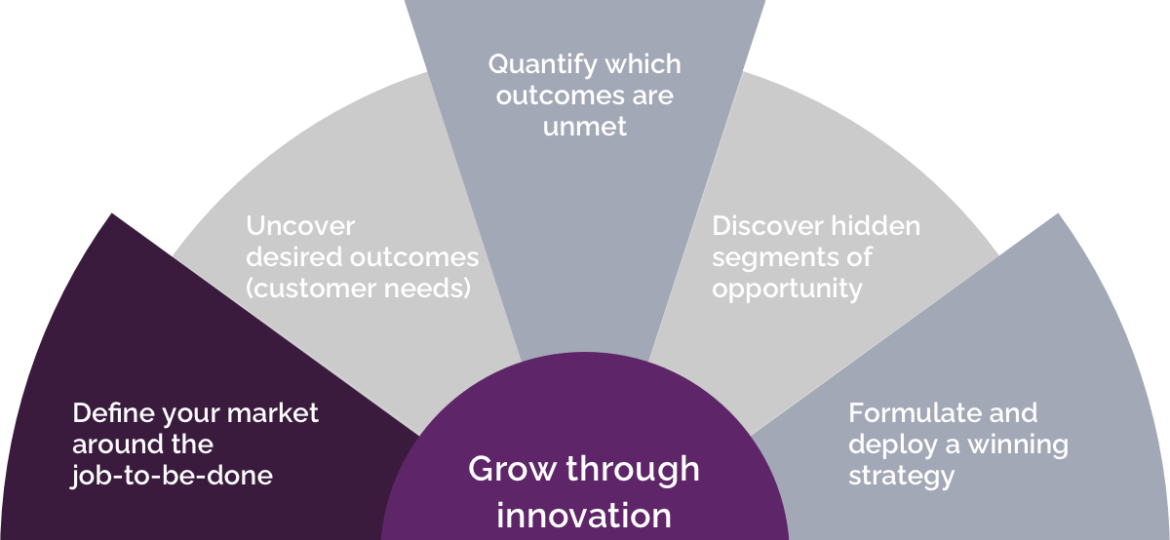

This article is based on an interview with Tony Ulwick, founder and CEO of Strategyn and the creator of Outcome-Driven Innovation, in which he explains what Outcome-Driven Innovation is and how it works. You can listen to the interview on A Faster Horse Podcast.
Outcome-Driven Innovation (ODI) is an innovation process based on Jobs-To-Be-Done theory. The basic idea starts with identifying what customer needs are and then creating a product — or modifying an existing product — to meet those needs.
It’s very methodical. The first four steps of the process are basic Marketing 101:
- Define who the customer is
- Define what their needs are
- Determine which of those needs are unmet, and
- Figure out whether there are groups of people with different unmet needs
It starts with identifying who the customer is — who it is that needs to get a job done — and what job exactly they need to get done.
The next task is to analyze all possible criteria by which the customer would judge the success of getting that job done. In some cases, that yields as many as 100 metrics or more by which the customer will judge the value of a product. In general, companies often find it difficult to define a “customer need,” but here the process is very specific.
After that, they will create a survey listing all of those metrics and asking customers or users to rank those metrics in terms of importance and also asking how well the product satisfies each of those metrics. That survey typically goes out to some 500-600 customers or users.
If an organization has the resources and training to do it, these steps can be carried out internally. Otherwise, they will typically hire a firm like The SearchLite to carry out the process for them.
The information gleaned from these first four steps can provide valuable insights, answering questions such as:
- What are our competitive strengths and weaknesses?
- Are there unmet needs that cut across the entire market that are high-leverage opportunities?
- Are there segments of customers who require different products or different feature sets?
- Are people willing to pay more to get the job done better?
Defining customer needs
Something that you call a customer need has to meet certain criteria. Among other things, it should be:
- Unambiguous
- Something that can be measured
- Something that can be controlled in the design of the product
- Stable over time
- Something that can be put in the survey and prioritized
- Something that describes
Where companies go wrong
Although it may sound obvious, some companies fail to realize that the entire organization is dependent upon understanding the customers’ needs.
There may also be too much variability in the innovation process: Within the company, different people or departments may be not be in agreement about what exactly a customer need is. Or they may not be able to agree on how to judge whether those needs are being met or not.
Another mistake many companies make these days — especially tech companies — is thinking that because they have many data points about their customers, sometimes hundreds or even thousands of data points, that that somehow equates to being able to understand the customer. But having data points and understanding what customer needs are — and how well those needs are or are not being met — are not the same thing.
‘Guess-and-check’
At some point, the organization has to come into agreement about what customer needs are and whether those needs are being met. If they don’t, they are following some version of the inefficient “guess-and-check” process — just guess what people want and try it out see if it works or not. (This is true both for physical products and virtual products like software. The difference is that it can feel more acceptable in the software world, because the changes are cheaper and faster, but most software products tend to fail because they don’t understand customer needs.)
Guess-and-check is inefficient and very expensive over the long term, but so many companies follow that process because they don’t want to invest the resources at the outset into understanding customer needs and designing a product around them.
‘Jobs are stable over time’
An investment in the ODI process is a long term, not a short-term, investment. That’s because these metrics — the criteria by which an organization can determine whether customers’ needs are being met — don’t change over time for a given product.
Or, as Tony Ulwick puts it, “Jobs are stable over time.” In other words, those same criteria can be used to determine whether a given product is meeting customers’ needs at any given time for many years to come.
